Ulster Unionist Party
The Ulster Unionist Party (UUP) is a unionist political party in Northern Ireland.[5] Having gathered support in Northern Ireland during the late-nineteenth and early-twentieth centuries, the party governed Northern Ireland between 1921 and 1972. It was supported by most unionist voters throughout the conflict known as the Troubles, during which time it was often referred to as the Official Unionist Party (OUP).[6][7] Between 1905 and 1972 its MPs took the Conservative whip at Westminster, in effect functioning as the Northern Irish branch of the Conservative Party. This arrangement came to an end in 1972 over disagreements over the Sunningdale Agreement. The two parties have remained institutionally separate ever since.
Ulster Unionist Party | |
|---|---|
.svg.png) | |
| Abbreviation | UUP |
| Leader | Steve Aiken |
| President | May Steele |
| Chairman | The Lord Empey |
| Founded | 3 March 1905 |
| Preceded by | Irish Unionist Alliance |
| Headquarters | Strandtown Hall 2-4 Belmont Road Belfast Northern Ireland |
| Youth wing | Young Unionists |
| Ideology |
|
| Political position | Centre-right[3] |
| European affiliation | Alliance of Conservatives and Reformists in Europe |
| UK affiliation | Conservative Party (1905–1972, 2008–2012) |
| Colours | Blue |
| House of Commons (NI Seats) | 0 / 18 |
| House of Lords | 2 / 777 |
| NI Assembly | 10 / 90 |
| Local government in Northern Ireland[4] | 75 / 462 |
| Website | |
| www | |
It is currently the fourth-largest party in Northern Ireland, having been overtaken in 2003 by the Democratic Unionist Party (DUP) and Sinn Féin, and in 2017 by the Social Democratic and Labour Party (SDLP). The party has been unrepresented in Westminster since losing its two seats in 2017. Most recently, the party won 11.7% of the vote in Northern Ireland and no seats in 2019, placing fifth behind the DUP, Sinn Féin, Alliance Party of Northern Ireland, and SDLP.
In 2016, the UUP and the SDLP decided not to accept the seats on the Northern Ireland Executive to which they would have been entitled and to form an official opposition to the executive. This marked the first time that a devolved government in Northern Ireland did not include the UUP. Steve Aiken succeeded Robin Swann as leader, in November 2019.[8]
History
1880s to 1921
The Ulster Unionist Party traces its formal existence back to the foundation of the Ulster Unionist Council in 1905. Before that, however, there had been a less formally organised Irish Unionist Alliance (IUA) since the late 19th century, usually dominated by unionists from Ulster. Modern organised unionism properly emerged after William Ewart Gladstone's introduction in 1886 of the first of three Home Rule Bills in response to demands by the Irish Parliamentary Party. The IUA was an alliance of Irish Conservatives and Liberal Unionists, the latter having split from the Liberal Party over the issue of home rule. It was the merger of these two parties in 1912 that gave rise to the current name of the Conservative and Unionist Party, to which the UUP was formally linked (to varying degrees) until 1985.
From the beginning, the party had a strong association with the Orange Order, a Protestant fraternal organisation. The original composition of the Ulster Unionist Council was 25% Orange delegates,[9] however this was reduced through the years. Although most unionist support was based in the geographic area that became Northern Ireland, there were at one time unionist enclaves throughout southern Ireland. Unionists in County Cork and Dublin were particularly influential. The initial leadership of the Ulster Unionist Party all came from outside what would later become Northern Ireland; men such as Colonel Saunderson, Viscount (later the Earl of) Midleton and the Dubliner Edward Carson, all members of the Irish Unionist Alliance. However, after the Irish Convention failed to reach an understanding on home rule and with the partition of Ireland under the Government of Ireland Act 1920, Irish unionism in effect split. Many southern unionist politicians quickly became reconciled with the new Irish Free State, sitting in its Seanad or joining its political parties. The existence of a separate Ulster Unionist Party became entrenched as the party took control of the new government of Northern Ireland.

The leadership of the UUP was taken by Sir Edward Carson in 1910. Throughout his 11-year leadership he fought a sustained campaign against Irish Home Rule, including being involved in the formation of the Ulster Volunteers (UVF) in 1912. In the 1918 general election, Carson switched constituencies from his former seat of Dublin University to Belfast Duncairn. Carson strongly opposed the partition of Ireland and the end of unionism as an all-Ireland political force, so he refused the opportunity to be Prime Minister of Northern Ireland or even to sit in the Northern Ireland House of Commons, citing a lack of connection with the place. The leadership of the UUP and, subsequently, Northern Ireland, was taken by Sir James Craig.
The Stormont era: Part of the Conservative Party
1920–1963
Until almost the very end of its period of power in Northern Ireland, the UUP was led by a combination of landed gentry (Basil Brooke, 1st Viscount Brookeborough, Hugh MacDowell Pollock and James Chichester-Clark), aristocracy (Terence O'Neill) and gentrified industrial magnates (James Craig, 1st Viscount Craigavon and John Miller Andrews – nephew of William Pirrie, 1st Viscount Pirrie). Only its last Prime Minister, Brian Faulkner, was from a middle-class background. During this era, all but 11 of the 149 UUP Stormont MPs were members of the Orange Order, as were all Prime Ministers.[10]
James Craig governed Northern Ireland from its inception until his death in 1940 and is buried with his wife by the east wing of Parliament Buildings. His successor, J. M. Andrews, was heavily criticised for appointing octogenarian veterans of Craigavon's administration to his cabinet. His government was also believed to be more interested in protecting the statue of Carson at the Stormont Estate than the citizens of Belfast during the Belfast blitz. A backbench revolt in 1943 resulted in his resignation and replacement by Sir Basil Brooke (later Viscount Brookeborough), although he was recognised as leader of the party until 1946.
Brookeborough, despite having felt that Craigavon had held on to power for too long, was Prime Minister for one year longer. During this time he was on more than one occasion called to meetings of the Grand Orange Lodge of Ireland to explain his actions, most notably following the 1947 Education Act which made the government responsible for the payment of National Insurance contributions of teachers in Catholic Church-controlled schools. Ian Paisley called for Brookeborough's resignation in 1953 when he refused to sack Brian Maginess and Clarence Graham, who had given speeches supporting re-admitting Catholics to the UUP.[11] He retired in 1963 and was replaced by Terence O'Neill, who emerged ahead of other candidates, Jack Andrews and Faulkner.
1963–1972
In the 1960s, identifying with the civil rights movement of Martin Luther King and encouraged by attempts at reform under O'Neill, various organisations campaigned for civil rights, calling for changes to the system for allocating public housing and the voting system for the local government franchise, which was restricted to (disproportionately Protestant) rate payers.[12][13][14][15] O'Neill had pushed through some reforms but in the process the Ulster Unionists became strongly divided. At the 1969 Stormont general election UUP candidates stood on both pro- and anti-O'Neill platforms. Several independent pro-O'Neill unionists challenging his critics, while the Protestant Unionist Party of Ian Paisley mounted a hard-line challenge. The result proved inconclusive for O'Neill, who resigned a short time later. His resignation was probably caused by a speech of James Chichester-Clark who stated that he disagreed with the timing, but not the principle, of universal suffrage at local elections.
Chichester-Clark won the leadership election to replace O'Neill and swiftly moved to implement many of O'Neill's reforms. Civil disorder continued to mount, culminating in August 1969 when Catholic Bogside residents clashed with the Royal Ulster Constabulary in Derry because of an Apprentice Boys of Derry march, sparking days of riots. Early in 1971, Chichester-Clark flew to London to request further military aid following the 1971 Scottish soldiers' killings. When this was all but refused, he resigned to be replaced by Brian Faulkner.
Faulkner's government struggled though 1971 and into 1972. After Bloody Sunday, the British Government threatened to remove control of the security forces from the devolved government. Faulkner reacted by resigning with his entire cabinet, and the British Government suspended, and eventually abolished, the Northern Ireland Parliament, replacing it with Direct Rule.
The liberal unionist group, the New Ulster Movement, which had advocated the policies of Terence O'Neill, left and formed the Alliance Party of Northern Ireland in April 1970, while the emergence of Ian Paisley's Protestant Unionist Party continued to draw off some working-class and more Ulster loyalist support.
1972–1995
In June 1973 the UUP won a majority of seats in the new Northern Ireland Assembly, but the party was divided on policy. The Sunningdale Agreement, which led to the formation of a power-sharing Executive under Ulster Unionist leader Brian Faulkner, ruptured the party. In the 1973 elections to the Executive the party found itself divided, a division that did not formally end until January 1974 with the triumph of the anti-Sunningdale faction. Faulkner was then overthrown, and he set up the Unionist Party of Northern Ireland (UPNI). The Ulster Unionists were then led by Harry West from 1974 until 1979. In the February 1974 general election, the party participated in the United Ulster Unionist Coalition (UUUC) with Vanguard and the Democratic Unionist Party, successor to the Protestant Unionist Party. The result was that the UUUC won 11 out of 12 parliamentary seats in Northern Ireland on a fiercely anti-Sunningdale platform, although they barely won 50% of the overall popular vote. This result was a fatal blow for the Executive, which soon collapsed.
Up until 1972 the UUP sat with the Conservative Party at Westminster, traditionally taking the Conservative parliamentary whip. To all intents and purposes the party functioned as the Northern Ireland branch of the Conservative Party. In 1972, in protest over the prorogation of the Parliament of Northern Ireland, the Westminster Ulster Unionist MPs withdrew from the alliance.[16][17][18] The party remained affiliated to the National Union of Conservative and Unionist Associations, but in 1985, withdrew from it as well, in protest over the Anglo-Irish Agreement. Subsequently, the Conservative Party has organised separately in Northern Ireland, with little electoral success.
Under West's leadership, the party recruited Enoch Powell, who became Ulster Unionist MP for South Down in October 1974 after defecting from the Conservatives. Powell advocated a policy of 'integration', whereby Northern Ireland would be administered as an integral part of the United Kingdom. This policy divided both the Ulster Unionists and the wider unionist movement, as Powell's ideas conflicted with those supporting a restoration of devolved government to Northern Ireland. The party also made gains upon the break-up of the Vanguard Party and its merger back into the Ulster Unionists. The separate United Ulster Unionist Party (UUUP) emerged from the remains of Vanguard but folded in the early 1980s, as did the UPNI. In both cases the main beneficiaries of this were the Ulster Unionists, now under the leadership of James Molyneaux (1979–95).
Trimble leadership
David Trimble led the party between 1995 and 2005. His support for the Belfast Agreement caused a rupture within the party into pro-agreement and anti-agreement factions. Trimble served as First Minister of Northern Ireland in the power-sharing administration created under the Belfast Agreement.
Unusually for a unionist party, the UUP had a Roman Catholic Member of the Legislative Assembly (MLA) (the Northern Ireland Legislative Assembly), Sir John Gorman until the 2003 election. In March 2005, the Orange Order voted to end its official links with the UUP, while still maintaining the same unofficial links as other interest groups. Trimble faced down Orange Order critics who tried to suspend him for his attendance at a Catholic funeral for a young boy killed by the Real IRA in the Omagh bombing. In a sign of unity, Trimble and President of Ireland Mary McAleese walked into the church together.
In the 2001 general election, the Ulster Unionists lost a number of seats belonging to UUP stalwarts; for example, John Taylor, the former deputy leader of the party, lost his seat of Strangford to Iris Robinson.
The party's misfortunes continued at the 2005 election. The party held six seats at Westminster immediately before the 2005 general election, down from seven after the previous general election following the defection of Jeffrey Donaldson in 2004. The election resulted in the loss of five of their six seats. The only seat won by an Ulster Unionist was North Down, by Sylvia Hermon, who had won the seat in the 2001 general election from Robert McCartney of United Kingdom Unionist Party. Only the Labour Party lost more seats in 2005. David Trimble himself lost his seat in Upper Bann and resigned as party leader soon after. The ensuing leadership election was won by Reg Empey.
Empey leadership
In May 2006 UUP leader Reg Empey attempted to create a new assembly group that would have included Progressive Unionist Party (PUP) leader David Ervine. The PUP is the political wing of the illegal Ulster Volunteer Force (UVF).[19][20][21][22][23] Many in the UUP, including the last remaining MP, Sylvia Hermon, were opposed to the move.[24][25] The link was in the form of a new group called the 'Ulster Unionist Party Assembly Group' whose membership was the 24 UUP MLAs and Ervine. Empey justified the link by stating that under the d'Hondt method for allocating ministers in the Assembly, the new group would take a seat in the Executive from Sinn Féin.
Following a request for a ruling from the DUP's Peter Robinson, the Speaker ruled that the UUPAG was not a political party within the meaning of the Political Parties, Elections and Referendums Act 2000.[26]
The party did poorly in the 2007 Northern Ireland Assembly election. The party retained 18 of its seats within the assembly.[27] Empey was the only leader of one of the four main parties not to be re-elected on first preference votes alone in the Assembly elections of March 2007.
In July 2008, the UUP and Conservative Party announced that a joint working group had been established to examine closer ties. On 26 February 2009, the Ulster Unionist Executive and area council of Northern Ireland Conservatives agreed to field joint candidates in future elections to the House of Commons and European Parliament under the name "Ulster Conservatives and Unionists – New Force". The agreement meant that Ulster Unionist MPs could have sat in a Conservative Government, renewing the relationship that had broken down in 1974 over the Sunningdale Agreement and in 1985 over the Anglo-Irish Agreement.[28][29][30] The UUP's sole remaining MP at the time, Sylvia Hermon, opposed the agreement, stating she would not be willing to stand under the UCUNF banner.[31]
In February 2010, Hermon confirmed that she would not be seeking a nomination as a Conservative/UUP candidate for the forthcoming general election.[32] On 25 March 2010, she formally resigned from the party and announced that she would be standing as an independent candidate at the general election.[33] As a result, the UUP were left without representation in the House of Commons for the first time since the party's creation.
At the 2010 general election, UCUNF won no seats in Northern Ireland (while Hermon won hers as an independent). The Ulster Conservatives and Unionists – New Force label was not used again. Following the election, Sir Reg Empey resigned as leader. He was replaced by Tom Elliott as party leader in the subsequent leadership election. During the leadership election, it emerged that a quarter of the UUP membership came from Fermanagh and South Tyrone, an area with about 6% of Northern Ireland's population, the constituency of Tom Elliott.[34] The Dublin-based political magazine, the Phoenix, described Elliott as a "blast from the past" and said that his election signified "a significant shift to the right" by the UUP.[35] Shortly after his election, three 2010 general election candidates resigned: Harry Hamilton, Paula Bradshaw and Trevor Ringland.[36] Bradshaw and Hamilton subsequently joined the Alliance Party.[37]
Since 2011
The party further declined in the 2011 Assembly elections (standing again as the UUP). It lost two seats and won fewer votes than the nationalist Social Democratic and Labour Party (SDLP) (although it won more seats than the SDLP) and two of its candidates, Bill Manwaring and Lesley Macaulay, subsequently joined the Conservative Party. In addition, east of the Bann, it lost seats to the Alliance Party. It was also overtaken by Alliance on Belfast City Council.[38] In November 2011, the Conservative Party chairman, Lord Feldman, wrote to Elliott to propose a formal and permanent merger of the two parties. The proposal, which had the backing of David Cameron, would have seen the UUP form the backbone of a new party called the Northern Ireland Conservative and Unionist Party (NICUP). Elliott rejected the merger and called the proposed dissolution of the UUP "unacceptable".[39]
Tom Elliott was criticised for comments he made in his victory speech where he described elements of Sinn Féin as "scum".[40] Elliott resigned in March 2012 saying some people had not given him a 'fair opportunity' to develop and progress many party initiatives.[41] Mike Nesbitt was elected leader on 31 March 2012, beating the only other candidate, John McCallister, by 536 votes to 129.[42]
The Conservatives and the UUP went their separate ways again,[43] with the Northern Ireland Conservatives relaunching as a separate party on 14 June 2012.[44]
Although their MEP seat, held by Jim Nicholson, had its vote percentage decreased slightly in the 2014 European election, the party managed to make gains in the local elections of that same day. They increased their share by 0.9%, making it the only party to increase its vote share, and gaining 15 seats as a result.
At the 2015 general election, the UUP returned to Westminster, gaining the South Antrim seat from the DUP and Fermanagh & South Tyrone (where they had an electoral pact with the DUP not standing) from Sinn Féin.[45]
In the 2016 European Union referendum the UUP supported the remain campaign, the UUP Executive passing a motion on 5 March 2016 that the party "believes that on balance Northern Ireland is better remaining in the European Union, with the UK Government pressing for further reform and a return to the founding principle of free trade, not greater political union. The Party respects that individual members may vote for withdrawal."[46][47]
At the 2017 general election the UUP lost both of its Commons seats, losing South Antrim to the DUP and Fermanagh & South Tyrone to Sinn Féin.[48] The party, which saw a significant decrease in its vote share, failed to take any other seats. They then lost their single MEP at the 2019 European Parliament elections.[49]
The party increased its vote share by 1.4% in the 2019 general election, but still failed to re-gain a seat. Their best 2019 result was in Fermanagh and South Tyrone, where they lost to Sinn Fein by 57 votes. As such the UUP currently has no representation in the House of Commons.
Leaders
| Image | Name | Tenure | Notes | |
|---|---|---|---|---|
 | Colonel Edward Saunderson | 1905 | 1906 | Also leader of the Irish Unionist Party |
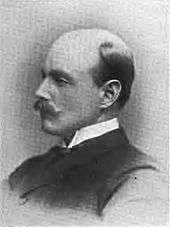 | Walter Hume Long | 1906 | 1910 | Also leader of the Irish Unionist Party |
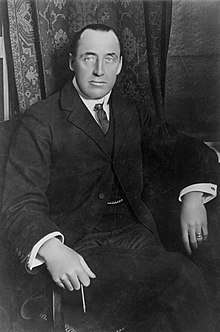 | Sir Edward Carson | 1910 | 1921 | Also leader of the Irish Unionist Party |
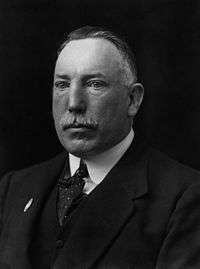 | The Viscount Craigavon | 1921 | 1940 | 1st Prime Minister of Northern Ireland |
 | John Miller Andrews | 1940 | 1943 | 2nd Prime Minister of Northern Ireland |
 | The Viscount Brookeborough | 1943 | 1963 | 3rd Prime Minister of Northern Ireland |
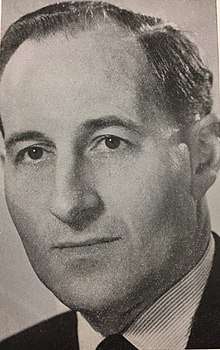 | Captain Terence O'Neill | 1963 | 1969 | 4th Prime Minister of Northern Ireland |
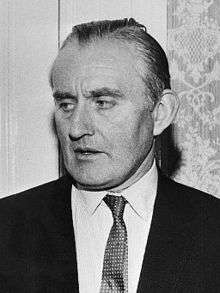 | James Chichester-Clark | 1969 | 1971 | 5th Prime Minister of Northern Ireland |
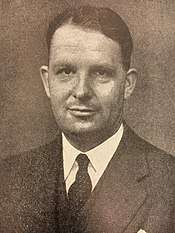 | Brian Faulkner | 1971 | 1974 | 6th and final Prime Minister of Northern Ireland |
 | Harry West | 1974 | 1979 | |
 | James Molyneaux | 1979 | 1995 | |
 | David Trimble | 1995 | 2005 | First Minister of Northern Ireland |
 | Sir Reg Empey | 2005 | 2010 | |
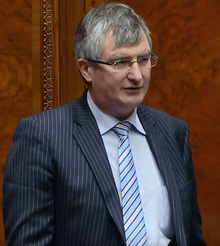 | Tom Elliott | 2010 | 2012 | |
| Mike Nesbitt | 2012 | 2017 | ||
.jpg) | Robin Swann | 2017 | 2019 | |
.png) | Steve Aiken | 2019 | Present | |
Structure
The UUP is still organised around the Ulster Unionist Council, which was from 1905 until 2004 the only legal representation of the party. Following the adoption of a new Constitution in 2004, the UUP has been an entity in its own right, however the UUC still exists as the supreme decision making body of the Party. In autumn 2007 the delegates system was done away with, and today all UUP members are members of the Ulster Unionist Council, with entitlements to vote for the Leader, party officers and on major policy decisions.
Each constituency in Northern Ireland forms the boundary of a UUP constituency association, which is made up of branches formed along local boundaries (usually district electoral areas). There are also four 'representative bodies', the Ulster Women's Unionist Council, the Ulster Young Unionist Council, the Westminster Unionist Association (the party's Great Britain branch) and the Ulster Unionist Councillors Association. Each constituency association and representative body elects a number of delegates to the Executive Committee, which governs many areas of party administration such as membership and candidate selection.
The UUP maintained a formal connection with the Orange Order from its foundation until 2005, and with the Apprentice Boys of Derry until 1975. While the party was considering structural reforms, including the connection with the Order, it was the Order itself that severed the connection in 2004. The connection with the Apprentice Boys was cut in a 1975 review of the party's structure as they had not taken up their delegates for several years beforehand.
Youth wing
The UUP's youth wing is the Young Unionists, first formed in 2004 as a rebrand of the Ulster Young Unionist Council, which formed in 1946. Many of its members have stayed with the party, such as the present leader of the UUP. Others have left to start other Unionist parties. Having disbanded twice, in 1974 and 2004, the Council was re-constituted by young activists in March 2004. This resulted in the Young Unionists (YU) becoming a representative body of the UUP and subject to its revamp of their Constitution.
Representatives
Parliament of the United Kingdom
Members of the House of Commons as of June 2017: The UUP lost its two seats in the 2017 election. South Antrim went to the DUP while Fermanagh and South Tyrone went to Sinn Féin
Members of the House of Lords as of June 2017:
Northern Ireland Assembly
Members of the Northern Ireland Assembly as elected in March 2017:
Party leadership
Party spokesmen
The current Party spokesman are:[50]
Party officers
The current party officers are:
| Classification | Name |
|---|---|
| Leader | Steve Aiken
|
| Party President | May Steele |
| Party Chairman | Lord Empey |
| Party Vice Chairman | Roy McCune |
| Assembly Group Representative | Robbie Butler |
| Westminster Representative | Lord Rogan |
| Party Treasurer | Alexander Redpath |
| Chairman of the Councillors' Association | Sam Nicholson |
| Leader's Nominee | Tom Elliott |
| Leader's Nominee | Jenny Palmer |
| Members' Nominee | George White |
| Members' Nominee | Joshua Lowery |
| Members' Nominee | Bethany Ferris |
Electoral performance
Westminster
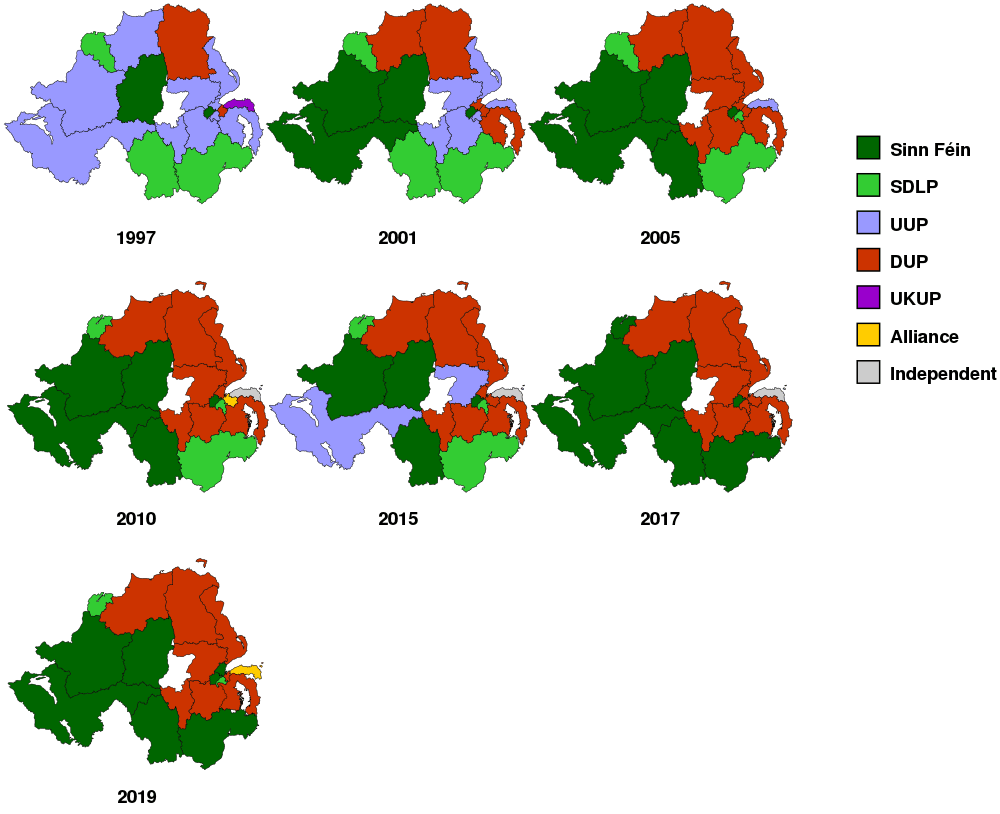
| Election | House of Commons | Share of votes | Seats | +/- | Outcome |
|---|---|---|---|---|---|
| 1922 | 32nd | 57.2% | 10 / 13 |
Government (with Conservative) | |
| 1923 | 33rd | 49.4% | 10 / 13 |
Opposition | |
| 1924 | 34th | 83.8% | 10 / 13 |
Government (with Conservative) | |
| 1929 | 35th | 68.0% | 9 / 13 |
Opposition | |
| 1931 | 36th | 56.1% | 11 / 13 |
National government | |
| 1935 | 37th | 64.9% | 9 / 13 |
National government | |
| 1945 | 38th | 61.0% | 9 / 13 |
Opposition | |
| 1950 | 39th | 62.8% | 10 / 12 |
Opposition | |
| 1951 | 40th | 59.4% | 9 / 12 |
Government (with Conservative) | |
| 1955 | 41st | 68.5% | 10 / 12 |
Government (with Conservative) | |
| 1959 | 42nd | 77.2% | 12 / 12 |
Government (with Conservative) | |
| 1964 | 43rd | 63.2% | 12 / 12 |
Opposition | |
| 1966 | 44th | 61.8% | 9 / 12 |
Opposition | |
| 1970 | 45th | 54.3% | 8 / 12 |
Government (with Conservative) until end of 1973, when whip and alliance with Conservative withdrawn caused snap election. | |
| Feb 1974 | 46th | 32.3% | 7 / 12 |
Opposition | |
| Oct 1974 | 47th | 36.5% | 6 / 12 |
Opposition | |
| 1979 | 48th | 36.6% | 5 / 12 |
Opposition | |
| 1983 | 49th | 34.0% | 11 / 17 |
Opposition | |
| 1987 | 50th | 37.8% | 9 / 17 |
Opposition | |
| 1992 | 51st | 34.5% | 9 / 17 |
Opposition | |
| 1997 | 52nd | 32.7% | 10 / 18 |
Opposition | |
| 2001 | 53rd | 26.7% | 6 / 18 |
Opposition | |
| 2005 | 54th | 17.7% | 1 / 18 |
Opposition | |
| 2010 | 55th | 15.2% | 0 / 18 |
N/A | |
| 2015 | 56th | 16.0% | 2 / 18 |
Opposition | |
| 2017 | 57th | 10.3% | 0 / 18 |
N/A | |
| 2019 | 58th | 11.7% | 0 / 18 |
N/A | |
Stormont
| Election | Body | First preference votes | Vote % | Seats | Outcome |
|---|---|---|---|---|---|
| 1921 | 1st Parliament | 343,347 | 66.9% | 40 / 52 |
UUP majority |
| 1925 | 2nd Parliament | 211,662 | 55.0% | 32 / 52 |
UUP majority |
| 1929 | 3rd Parliament | 148,579 | 50.8% | 37 / 52 |
UUP majority |
| 1933 | 4th Parliament | 73,791 | 43.5% | 36 / 52 |
UUP majority |
| 1938 | 5th Parliament | 187,684 | 56.8% | 39 / 52 |
UUP majority |
| 1945 | 6th Parliament | 180,342 | 50.4% | 33 / 52 |
UUP majority |
| 1949 | 7th Parliament | 237,411 | 62.7% | 37 / 52 |
UUP majority |
| 1953 | 8th Parliament | 125,379 | 48.6% | 38 / 52 |
UUP majority |
| 1958 | 9th Parliament | 106,177 | 44.0% | 37 / 52 |
UUP majority |
| 1962 | 10th Parliament | 147,629 | 48.8% | 34 / 52 |
UUP majority |
| 1965 | 11th Parliament | 191,896 | 59.1% | 36 / 52 |
UUP majority |
| 1969 | 12th Parliament | 269,501 | 48.2% | 36 / 52 |
UUP majority |
| 1973 | 1973 Assembly | 258,790 | 35.8% | 31 / 78 |
Largest party; coalition with SDLP and Alliance Party of Northern Ireland |
| 1975 | Constitutional Convention | 167,214 | 25.4% | 19 / 78 |
Largest party |
| 1982 | 1982 Assembly | 188,277 | 29.7% | 26 / 78 |
Largest party |
| 1996 | Forum | 181,829 | 24.2% | 30 / 110 |
Largest party |
| 1998 | 1st Assembly | 172,225 | 21.3% | 28 / 108 |
Largest party; coalition |
| 2003 | 2nd Assembly | 156,931 | 22.7% | 27 / 108 |
Direct rule |
| 2007 | 3rd Assembly | 103,145 | 14.9% | 18 / 108 |
Coalition |
| 2011 | 4th Assembly | 87,531 | 13.2% | 16 / 108 |
Coalition |
| 2016 | 5th Assembly | 87,302 | 12.6% | 16 / 108 |
Opposition |
| 2017 | 6th Assembly | 103,314 | 12.9% | 10 / 90 |
Coalition |
Local government
| Election | First-preference vote | Vote % | Seats |
|---|---|---|---|
| 1973 | 255,187 | 17.0% | 194 / 517 |
| 1977 | 166,971 | 30.0% | 176 / 526 |
| 1981 | 175,965 | 26.4% | 151 / 526 |
| 1985 | 188,497 | 29.5% | 189 / 565 |
| 1989 | 193,064 | 31.3% | 194 / 565 |
| 1993 | 184,082 | 29.0% | 197 / 582 |
| 1997 | 175,036 | 28.0% | 185 / 575 |
| 2001 | 181,336 | 23.0% | 154 / 582 |
| 2005 | 126,317 | 18.0% | 115 / 582 |
| 2011 | 100,643 | 15.2% | 99 / 583 |
| 2014 | 101,385 | 16.1% | 88 / 462 |
| 2019 | 95,320 | 14.1% | 75 / 462 |
See also
References
- Nordsieck, Wolfram (2017). "Northern Ireland/UK". Parties and Elections in Europe. Archived from the original on 7 November 2016. Retrieved 28 September 2018.
- "Nesbitt says NI needs liberal progressive politicians". Belfast Newsletter. Archived from the original on 26 April 2016. Retrieved 14 April 2016.
- Ari-Veikko Anttiroiko; Matti Mälkiä (2007). Encyclopedia of Digital Government. Idea Group Inc (IGI). pp. 394–. ISBN 978-1-59140-790-4. Archived from the original on 25 December 2018. Retrieved 17 October 2015.
- "Local Council Political Compositions". Open Council Date UK. 7 January 2018. Archived from the original on 30 September 2017. Retrieved 7 January 2018.
- "NI parties step on election trail". BBC News. 5 April 2005. Archived from the original on 9 May 2007. Retrieved 9 April 2010.
- "Abstracts of Organisations - 'U'". Conflict Archive on the Internet. University of Ulster. 23 September 2015. Ulster Unionist Party (UUP). Archived from the original on 22 February 2011. Retrieved 17 June 2016.
- "Ulster Unionist Party". Politics 97. BBC. 1997. Archived from the original on 6 May 2017. Retrieved 17 June 2016.
- "Steve Aiken takes over as new leader of Ulster Unionist Party". BBC. 9 November 2019. Archived from the original on 9 November 2019. Retrieved 9 November 2019.
- John Harbinson (1973) The Ulster Unionist Party, 1882–1973. Belfast: Blackstaff Press ISBN 0-85640-007-6
- "Archived copy" (PDF). Archived (PDF) from the original on 4 March 2016. Retrieved 11 November 2015.CS1 maint: archived copy as title (link)
- "A Tragedy of Errors".
- "Archived copy". Archived from the original on 3 September 2017. Retrieved 17 September 2017.CS1 maint: archived copy as title (link)
- "Human Rights as War by Other Means".
- "Northern Ireland". Archived from the original on 15 December 2019. Retrieved 17 September 2017.
- "BBC - History - The Troubles, 1963 to 1985". Archived from the original on 3 October 2019. Retrieved 25 December 2019.
- "Tories form Northern Ireland party". belfasttelegraph. ISSN 0307-1235. Retrieved 17 April 2020.
- Dan Keohane (2000), Security in British Politics 1945-99, p. 183.
- Stuart Bell and Anthony Seldon, The Heath Government 1970-74: A Reappraisal.
- "What is the UVF?". BBC News. 14 September 2005. Archived from the original on 22 December 2006. Retrieved 9 April 2010.
- McDonald, Henry (8 January 2007). "David Ervine". The Guardian. London. Archived from the original on 19 January 2007. Retrieved 9 April 2010.
- Federation of American Scientists Archived 5 July 2007 at the Wayback Machine
- McKittrick, David (26 July 2005). "Feuding loyalists bring the fear back to Belfast". The Independent. London. Archived from the original on 15 December 2005. Retrieved 9 April 2010.
- "Viasat Internet | Provider of Fast Satellite Internet". ViaSat Internet Provider. Archived from the original on 18 August 2019. Retrieved 19 August 2019.
- "Row as Ervine joins UUP grouping". BBC News. 15 May 2006. Archived from the original on 8 March 2008. Retrieved 9 April 2010.
- "MP 'distressed' over Ervine move". BBC News. 17 May 2006. Archived from the original on 8 March 2008. Retrieved 9 April 2010.
- "UUP-PUP link 'against the rules'". BBC News. 11 September 2006. Retrieved 9 April 2010.
- DUP top in NI assembly election Archived 21 March 2007 at the Wayback Machine, BBC News Online, 12 March 2007.
- "Lady Hermon under 'no pressure'". BBC News. 27 February 2009. Archived from the original on 2 March 2009. Retrieved 27 March 2010.
- Devenport, Mark (12 May 2009). "Profile: Jim Nicholson". BBC News Online. Archived from the original on 5 February 2015. Retrieved 30 May 2009.
- David Cameron launches biggest Conservative shake-up for decades Archived 23 February 2011 at the Wayback Machine The Daily Telegraph (London), 23 July 2008.
- Hermon: why she rejected Tory deal Archived 11 May 2010 at the Wayback Machine Belfast Telegraph, 14 May 2009.
- UUP MP Lady Sylvia Hermon rejects UCUNF candidacy Archived 27 February 2010 at the Wayback Machine BBC News, 23 February 2010.
- MP Lady Sylvia Hermon quits Ulster Unionists Archived 28 March 2010 at the Wayback Machine BBC News, 25 March 2010.
- "Legal threat to the UUP leadership race ebbs". Belfast Telegraph. 17 September 2010. Archived from the original on 5 July 2015. Retrieved 16 January 2015.
- "Phoenix Magazine - Subscriber - Login" (PDF).
- "Troubled backdrop to UUP conference". www.newsletter.co.uk. Archived from the original on 19 August 2019. Retrieved 19 August 2019.
- "Queen tribute singer Harry Hamilton with Alliance Party". BBC News. 14 January 2011. Archived from the original on 4 January 2018. Retrieved 20 June 2018.
- "'Magnificent' council result for Alliance". u.tv. Archived from the original on 13 May 2011. Retrieved 10 May 2011.
- "Conservatives want UUP to disband and form new Tory-led party". BBC News. 11 November 2011. Archived from the original on 3 August 2017. Retrieved 20 June 2018.
- "DUP and Sinn Féin top polls in NI Assembly elections". The Irish Times. 5 May 2011. Archived from the original on 3 November 2011. Retrieved 8 May 2011.
- Purdy, Martina (9 March 2012). "UUP leader Tom Elliott quitting as party leader". BBC News Online. Archived from the original on 8 March 2017. Retrieved 11 January 2016.
- "Mike Nesbitt is new Ulster Unionist leader". BBC News Online. 31 March 2012. Archived from the original on 31 January 2016. Retrieved 11 January 2016.
- "Can rebranded Northern Ireland Conservatives deliver?". BBC News. 14 June 2012. Archived from the original on 8 October 2018. Retrieved 20 June 2018.
- Polley, Owen (14 June 2012). "NI Conservatives launch as fresh, centre-right party, in Belfast". NI Conservatives. Belfast. Archived from the original on 24 November 2013. Retrieved 15 June 2012.
- "Election 2015 results: Northern Ireland". BBC News. 6 May 2015. Archived from the original on 28 February 2018. Retrieved 20 June 2018.
- Ulster Unionist Party. "Statement from the Ulster Unionist Party on EU Referendum". Ulster Unionist Party. Archived from the original on 6 March 2016. Retrieved 5 March 2016.
- "Ulster Unionist Party supports staying in EU". Belfast Telegraph. 5 March 2016. Archived from the original on 22 March 2019. Retrieved 22 March 2019.
- "Election 2017 results: Northern Ireland". BBC News. 9 June 2017. Archived from the original on 10 June 2017. Retrieved 20 June 2018.
- "UUP members will decide if they want someone else to lead, says Swann". belfasttelegraph. ISSN 0307-1235. Retrieved 5 April 2020.
- Our People - MLAs Archived 24 February 2014 at the Wayback Machine Ulster Unionist Party